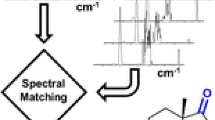Abstract
For compounds dissolved in non-polar solvents, nuclear magnetic resonance spectroscopic investigations have benefited greatly from the advent of cryogenically cooled probes. Unfortunately the allure of significant increases in sensitivity may not be realized for compounds such as metabolites that are dissolved in solvents with high ionic-strengths such as solutions typically utilized for metabolomic or biomolecular investigations. In some cases there is little benefit from a cryogenically cooled probe over a conventional room temperature probe. Various sample preparation methods have been developed to minimize the detrimental effects of salt; for large numbers of metabolomic samples these preparation methods tend to be onerous and impractical. An alternative to manipulating the sample, is to utilize a probe that is designed to have a higher tolerance for solutions with high ionic-strengths. In order to acquire high-quality optimal data and choose the appropriate probe configuration (especially important for comparative quantitative investigations) the effects of salts and buffers on cryogenic probe performance must be understood. Herein we detail sample considerations for two cryogenic probes, a standard 5 mm and a narrow diameter 1.7 mm, in an effort to identify via integrals, intensities and noise levels the optimal choice for biomolecular investigations.

Similar content being viewed by others
Notes
In previous investigations with hundreds of metabolomic samples, as long as the height of the samples were consistent, the automated shimming routine described within the supplemental information produced a very homogeneous field with replicates in different tubes having marginal differences in line-widths for both probes. Only when the height of the sample was low did the shimming routine fail.
References
Babu, C. R., Flynn, P. F., Wand, A. J. (2003). Preparation, characterization, and NMR spectroscopy of encapsulated proteins dissolved in low viscosity fluids. Journal of Biomolecular NMR, 25(4):313–323.
Borun, A., Florczak, A., Bald, A. (2010). Conductance studies of NaCl, KCl, NaBr, NaI, NaBPh4, Bu4NI, and NaClO4 in water + 2-butoxyethanol mixtures at T = 298.15 K. Journal of Chemical and Engineering, 55(9):3725–3730.
Burton, I. W., Quilliam, M. A., Walter, J. A. (2005). Quantitative 1H NMR with external standards: use in preparation of calibration solutions for algal toxins and other natural products. Analytical Chemistry, 77(10):3123–3131.
de Swiet, T. M. (2005). Optimal electric fields for different sample shapes in high resolution NMR spectroscopy. Journal of Magnetic Resonance, 174(2):331–334.
Ehrhardt, M. R., Flynn, P. F., Wand, A. J. (1999). Preparation of encapsulated proteins dissolved in low viscosity fluids. Journal of Biomolecular NMR, 14(1):75–78.
Goddard, T. D., Kneller, D. G. (2007). SPARKY 3. San Francisco: University of California.
Horiuchi, T., Takahashi, M., Kikuchi, J., Yokoyama, S., Maeda, H. (2005). Effect of dielectric properties of solvents on the quality factor for a beyond 900 MHz cryogenic probe model. Journal of Magnetic Resonance, 174(1):34–42.
Hoult, D. I. (2000). The principle of reciprocity in signal strength calculations-a mathematical guide. Concepts in Magnetic Resonance, 12(4):173–187.
Hoult, D. I., Lauterbur, P. C. (1979). The sensitivity of the zeugmatographic experiment involving human samples. Journal of Magnetic Resonance, 34(2):425–433.
Hoult, D. I., Richards, R. E. (1976). The signal-to-noise ratio of the nuclear magnetic resonance experiment. Journal of Magnetic Resonance, 24(1):71–85.
Kelly, A. E., Ou, H. D., Withers, R., Dotsch, V. (2002). Low-conductivity buffers for high-sensitivity NMR measurements. Journal of the American Chemical Society, 124(40):12013–12019.
Lane, A. N., Arumugam, S. (2005). Improving NMR sensitivity in room temperature and cooled probes with dipolar ions. Journal of Magnetic Resonance, 173(2):339–343.
Laurents, D. V., Scholtz, J. M., Rico, M., Pace, C. N., Bruix, M. (2005). Ribonuclease Sa conformational stability studied by NMR-monitored hydrogen exchange. Biochemistry, 44(21):7644-7655.
Martin, G. E. (2006). Applications of cryogenic NMR probe technology for the identification of low-level impurities in pharmaceuticals. In G. A. Webb (Ed.), Modern magnetic resonance (pp. 1205–1212). Dordrecht: Springer.
Robosky, L. C., Reily, M. D., Avizonis, D. (2007). Improving NMR sensitivity by use of salt-tolerant cryogenically cooled probes. Analytical and Bioanalytical Chemistry, 387(2):529–532.
Rossi, P., Swapna, G. V. T., Huang, Y. J., Aramini, J. M., Anklin, C., Conover, K., Hamilton, K., Xiao, R., Acton, T. B., Ertekin, A., Everett, J. K., Montelione, G. T. (2010). A microscale protein NMR sample screening pipeline. Journal of Biomolecular NMR, 46(1):11–22.
Smith, J. P., Hinson-Smith, V. (2001). Product review: High-resolution NMR gets even better. Anal Chem, 73(5):155–158.
Tadeo, X., Castano, D., Millet, O. (2007). Anion modulation of the 1H/2H exchange rates in backbone amide protons monitored by NMR spectroscopy. Protein Sci, 16(12):2733–2740.
Voehler, M. W., Collier, G., Young, J. K., Stone, M. P., Germann, M. W. (2006). Performance of cryogenic probes as a function of ionic strength and sample tube geometry. Journal of Magnetic Resonance, 183(1):102–109.
Wu, P. S. C., Otting, G. (2000). Rapid pulse length determination in high-resolution NMR. Journal of Magnetic Resonance, 176(1):115–119.
Acknowledgements
This work was supported by a Natural Sciences and Engineering Research Council Discovery grant to RTS through his adjunct appointment with Dalhousie University. Magnetic resonance data was collected at the Biomolecular Magnetic Resonance Facility (BMRF) housed at the National Research Council of Canada’s Institute for Marine Biosciences in Halifax. The cryogenic probes were provided by Dalhousie University through an Atlantic Canada Opportunities Agency (ACOA) Grant. We thank Ian Burton, John Walter and Tobias Karakach for stimulating and insightful discussions.
Author information
Authors and Affiliations
Corresponding author
Electronic supplementary material
Below is the link to the electronic supplementary material.
Rights and permissions
About this article
Cite this article
Biswas, Z., Merkley, N. & Syvitski, R.T. Biomolecular sample considerations essential for optimal performance from cryogenic probes. Metabolomics 10, 607–615 (2014). https://doi.org/10.1007/s11306-013-0620-z
Received:
Accepted:
Published:
Issue Date:
DOI: https://doi.org/10.1007/s11306-013-0620-z




